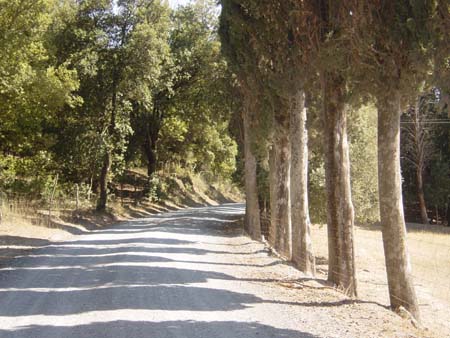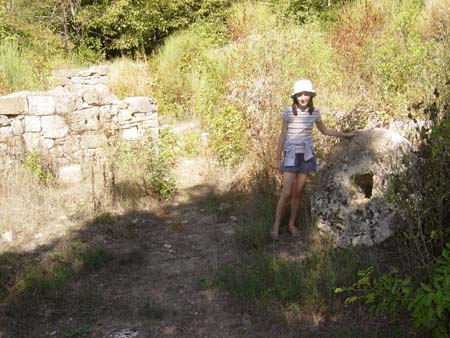Tuesday, September 16
Steve and Paula: Tonight we both agreed that this was one of the best days we've had since our travels began in June. We had been hoping for several days to find a private guide who could walk through the countryside with us, and talk about Tuscany and its history, landscape and winemaking. We were extremely fortunate to have connected with Roberta Marioni, a charming Italian woman who has been guiding in Italy for the past 15 years. Roberta also happens to be a "Master of Wine" (an official title) - perfect for our desire to learn all about these wines that we've loved so much.
Roberta told us on the phone about a great trek where we'd have the opportunity
to walk among hills, vineyards, forests and ruins, eventually approaching
the medieval town of San Gimignano. This sounded perfect, especially since
San Gimignano was definitely a place we wanted to see. We met Roberta outside
the city walls, and drove together to the starting point of our hike. The
drive took 20 minutes, and we couldn't help but wonder how long of a walk
we had signed up for…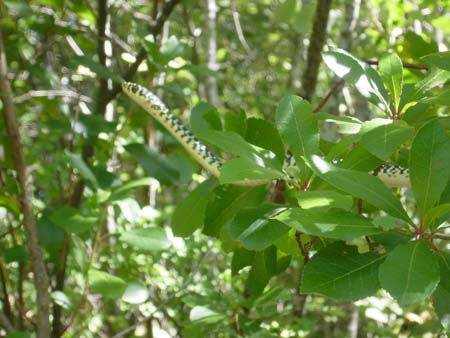
The walk began on a gravel road through a wooded area, and Roberta began
telling us about the history of Tuscany. Along the way, we enjoyed an encounter
with a local tree snake and numerous lizards. Roberta also pointed out local
plants including wild grapes (they grow all over Italy), and the white pistachio
plant (used for food, dyes, spices and even chewing gum). 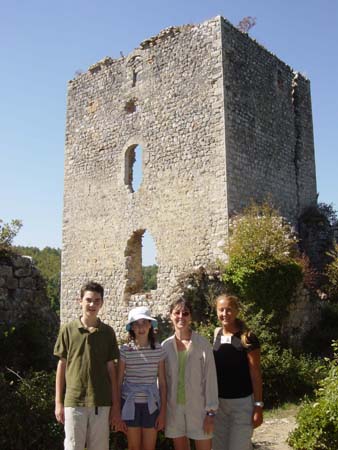
Our first stop was in Castel Vecchio, a well-preserved medieval village located
deep in the forest and overlooking densely-wooded valleys. This was really
very special. Since Castel Vecchio is about a 30 minute walk from the road,
very few tourists come here and we were able to explore the ruins on our own.
We learned that the village was created in the 12th century and was abandoned
in the 16th century after being dev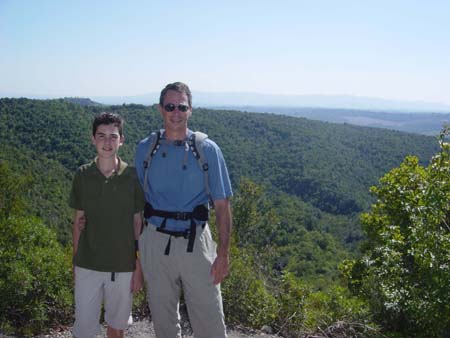 astated
by the plague. Because of its remote location, the remains of Castel Vecchio
were left undisturbed, which is why it has been so well preserved (many medieval
villages were destroyed when their rocks were removed and reused for other
purposes). The ruins include a Romanesque church (with some frescoes still
visible), a mill room, towers and a gate.
astated
by the plague. Because of its remote location, the remains of Castel Vecchio
were left undisturbed, which is why it has been so well preserved (many medieval
villages were destroyed when their rocks were removed and reused for other
purposes). The ruins include a Romanesque church (with some frescoes still
visible), a mill room, towers and a gate.
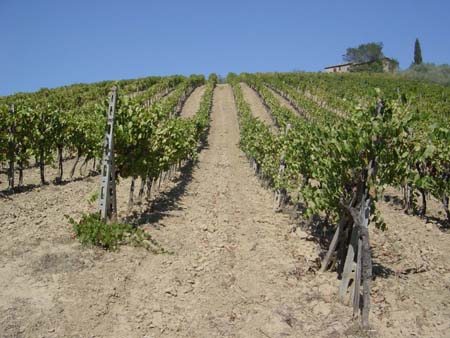
From Castel Vecchio, we continued up and down steep trails in the forest
and a dry river bed before joining a gravel road. Along the way, Roberta gave
us a great lesson about Italian wine. We learned about the history of how
the Etruscans originally cultivated the grapes, and how methods for production
have changed throughout the centuries. We were surprised to learn that the
vineyards of Europe were all destroyed in the late 19th century by an insect
(we'll have to find out more). The vineyards were then replaced with plants
grown in America - therefore all the vineyards we see today are actually descended
from American grapes. Roberta told us about how the grapes are grown and cultivated,
the varieties of grapes used, the laws surrounding wine-making (Roberta also
has a law degree!), and the characteristics of the various 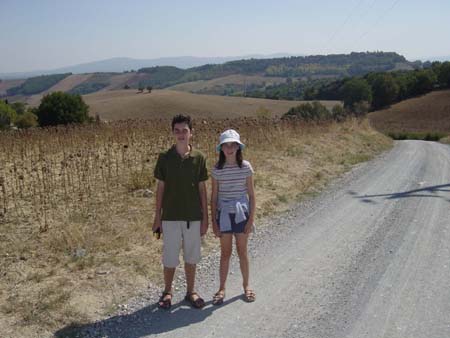 winemaking
regions. Roberta is hoping to pass the very challenging exam which would enable
her to become a professional wine taster, and perhaps become the first woman
on Italy's official wine tasting commission. It was fascinating to learn about
what's required to achieve these levels of mastery. We couldn't stop asking
Roberta questions about wine!
winemaking
regions. Roberta is hoping to pass the very challenging exam which would enable
her to become a professional wine taster, and perhaps become the first woman
on Italy's official wine tasting commission. It was fascinating to learn about
what's required to achieve these levels of mastery. We couldn't stop asking
Roberta questions about wine!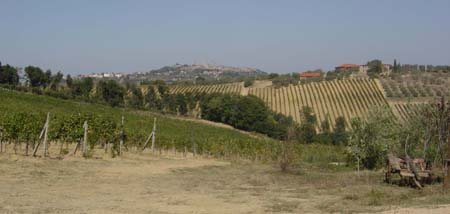
After passing through a variety of farms and vineyards, San Gimignano came
into view. We could clearly make out its towers and majestic setting on top
of a hill. We stopped here and enjoyed a quick picnic lunch. Roberta brought
some dessert wine (Vin Santo) with her, and she showed us how the Italians
like to dip biscotti into the wine - we're normally not big on dessert wines,
but this was very good. We also had stopped under a walnut tree, and David
enjoyed breaking open the nuts for us to eat and enjoy.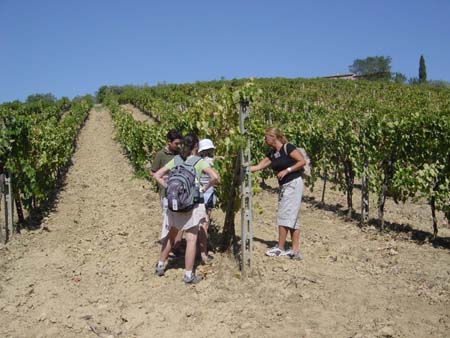
Our next stop was in the middle of a vineyard where Roberta helped us find
bunches of grapes that were still on the vines and had clearly been missed
by the recent harvest. Since they had been missed, we didn't feel too guilty
about helping ourselves to sweet treats. Roberta was able to identify the
varieties of grapes by their leaves, and also showed us how the farmer had
been training the branches to grow along the wires in the rows. She explained
the various training methods that are used, and the characteristics of the
plants in professionally-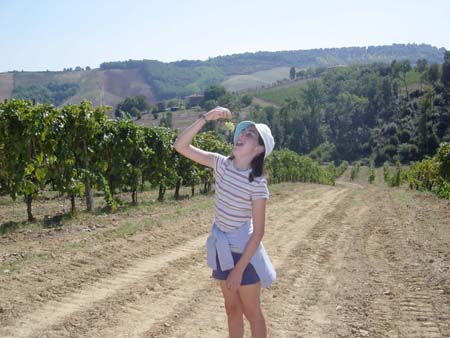 maintained
vineyards. We also found a fig tree and found the figs to be ripe and ready
to eat.
maintained
vineyards. We also found a fig tree and found the figs to be ripe and ready
to eat.
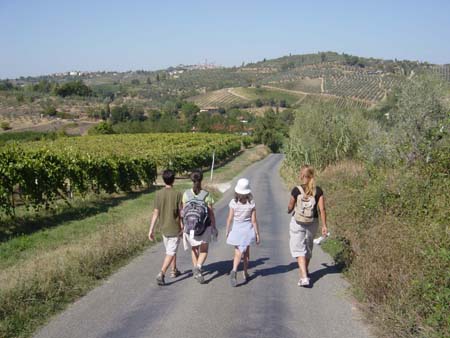
Our hike continued for a total of 8 miles, passing through several beautiful
hillside estates - these would be wonderful places to live! After 4 ½
hours, we finally arrived at the gate to San Gimignano. San Gimignano became
a town in 1200, and was ideally situated on the route traveled by pilgrims
from Europe on their way to Rome. Because of its location, the town became
a commercial center and prospered. San Gimignano's most notable feature is
its 14 remaining towers (out of 72 originally there), each built as symbols
of wealth and prestige by families who could afford this 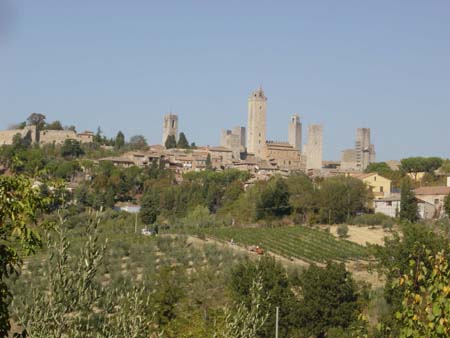 luxury.
San Gimignano was eventually conquered by the Florentines in the 1300's who
wanted to divert the trade routes so that they went through Florence. This
resulted in San Gimignano losing its wealth, and therefore there was no money
available to fund further development and expansion. This accounts for San
Gimignano's appearance today being largely unchanged from how it looked in
the medieval ages (as opposed to cities like Siena which has undergone radical
reconstruction). This is largely why over 2 million tourists visit San Gimignano
each year (invading the town's 7,000 residents). Fortunately, by the time
we arrived late this afternoon, most of the tourist buses had left for the
day.
luxury.
San Gimignano was eventually conquered by the Florentines in the 1300's who
wanted to divert the trade routes so that they went through Florence. This
resulted in San Gimignano losing its wealth, and therefore there was no money
available to fund further development and expansion. This accounts for San
Gimignano's appearance today being largely unchanged from how it looked in
the medieval ages (as opposed to cities like Siena which has undergone radical
reconstruction). This is largely why over 2 million tourists visit San Gimignano
each year (invading the town's 7,000 residents). Fortunately, by the time
we arrived late this afternoon, most of the tourist buses had left for the
day.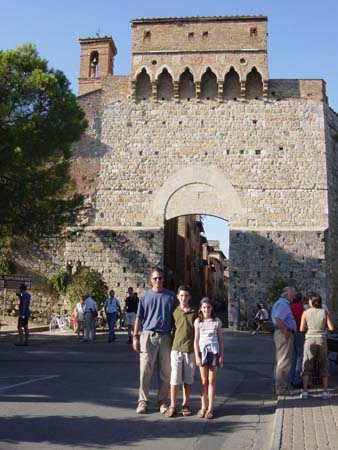
The town of San Gimignano is very beautiful. The main street is lined with
very interesting shops, and there are many narrow (and often dark) side-streets
and alleys. The views from San Gimignano across Tuscany are spectacular. Roberta
told us about San Gimignano's history and architecture, and explained how
the city is particularly well-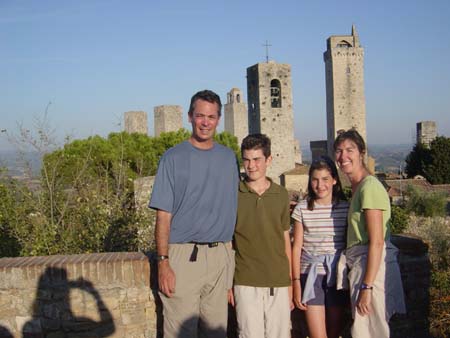 known
for the style and decoration of its windows. From inside the walls, you can
see that there are actually two sets of twin towers, each set built by particularly
rich families (they also happened to be fierce enemies). It was great to wander
through the streets and to take in all the history and architecture of this
very special place.
known
for the style and decoration of its windows. From inside the walls, you can
see that there are actually two sets of twin towers, each set built by particularly
rich families (they also happened to be fierce enemies). It was great to wander
through the streets and to take in all the history and architecture of this
very special place.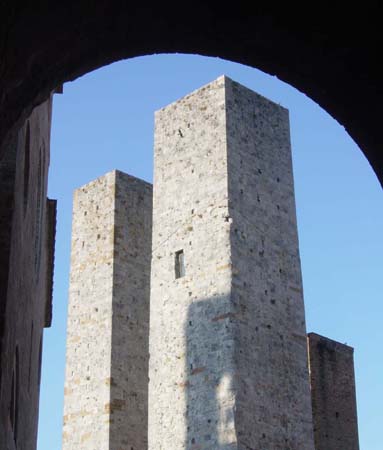
Before we let Roberta go for the day, we stopped in a wine shop. She had
promised a lesson in wine tasting, and we just couldn't pass up this opportunity!
Roberta selected a wine that she knew well, ordered two glasses, and took
us outside for a wonderful lesson on wine tasting. She took us wonderfully
through the process of observing, smelling and tasting the wine. We all had
fun trying to identify the colors and smells present in the wine, and waited
very impatiently until Roberta would finally let us actually taste it! David
and Katie really enjoyed this experience, and they now having fun pretending
that they're some kind of wine experts…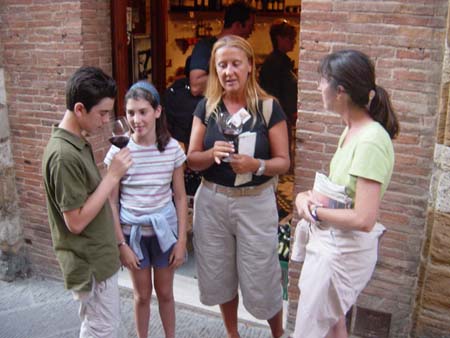
We had a pasta dinner at local restaurant called La Bettola del Grillo. Our
new taste treat for the day was ribollita, a very thick and good Tuscan bean/vegetable
soup with bread mixed in. We also enjoyed tiramisu, one of our favorite desserts.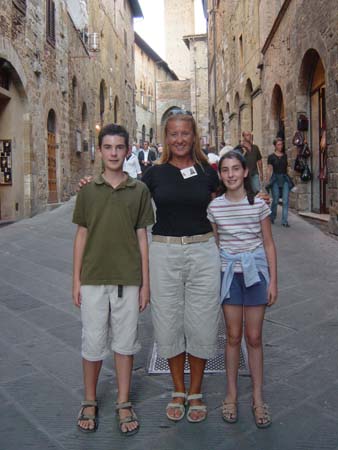
This was the longest we've walked since our hikes in the Alps, and was definitely a very special day. We enjoyed our time with Roberta so much that we arranged to meet her again for another day. This time we'll visit one of her favorite areas of Tuscany - the southern towns of Montalcino and Pienza. Montalcino is where Brunello wine is made -it's considered to be one of Italy's finest reds and we can't wait!
Tomorrow we will spend the day back home at Ponte a Bozzone - a very well-deserved day of relaxation.
Distance Walked: 10.34 miles